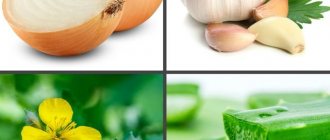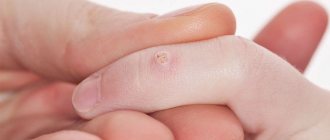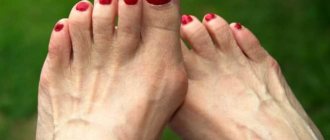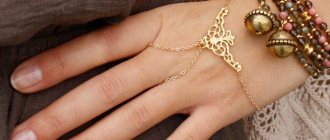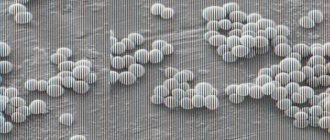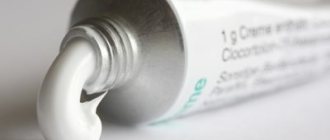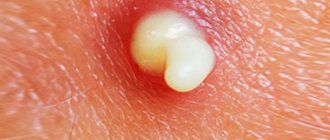Provoking factors
The inflammatory process that causes a boil to appear on the hand begins when bacteria and microbes enter the skin.
This can be facilitated by:
- wounds or damage to the skin, even the most minor and invisible,
- tight clothing that rubs and causes irritation,
- skin interaction with chemicals,
- diabetes,
- lack or insufficient effectiveness of hygiene procedures,
- weak immunity,
- lack of vitamins and poor nutrition,
- staphylococcus,
- sudden climate change,
- nervous tension, stress and neuroses.
Even excessive sweating, activities associated with dust, as well as otitis and rhinitis can contribute to the appearance of a boil, since these factors contribute to the proliferation of bacteria.
Causes of a sore finger near a toenail or hand nail
One of the most common causes of inflammation of the finger in the nail area is incorrect performance of pedicure and manicure.
Careless actions can damage the cuticle and provoke an inflammatory process with further accumulation of pus around the nail. Typically, such inflammation is caused by streptococcal and staphylococcal microorganisms that live on the skin of every person.
The development of the inflammatory process is influenced by certain conditions, such as:
- decrease in the body's immune forces
- presence of severe concomitant blood diseases
- metabolic disorders.
- fungus on the feet or nails.
Most cases of felon development occur after injury to the skin on the fingers. Moreover, the inflammatory process can occur even due to minor injuries - abrasions, scratches or splinters, cracks due to the skin being too dry and flaking. An infection penetrates the skin, which gives rise to purulent inflammation. For this reason, even minor wounds should be immediately treated with alcohol-containing solutions or iodine. Hangnails can also cause inflammation and the formation of pus in the tissues of the finger near the nail.
They arise due to a lack of vitamins in the body or injuries to the skin and are open wounds. They can also become infected and then form an abscess.
People at risk of getting hangnails on their fingers:
|
Symptoms in adults and clinical manifestations in children
Symptoms and manifestations in children and adults are the same; there are some differences due to the characteristics of the body. But the places of education are in most cases different. In adults, boils most often occur on the elbow - due to uncomfortable clothing and increased separation. And for children - on the fingers of their palms. This happens because children are much more likely to be outside, interacting with nature and, accordingly, dirt, and wash their hands much less often. In addition, young children are curious and careless, and because of this they often get dirty and get small wounds.
It is easier to treat a boil on the elbow than on the finger, because the fingers and palms are constantly interacting with the outside world and are never in a calm position. Externally, it is a purulent blister or pimple, which has several stages of development:
- A small reddish lump forms.
- The inflammatory process develops and affects the layers of the epidermis, the lump acquires a bright burgundy color.
- There is an accumulation of pus inside, and on the top layer you can see a greenish liquid.
- After a couple of days, a white rod can be seen in the center of the abscess.
- As soon as there is too much pus, the abscess opens and the entire contents of the boil flow out.
- After another 3 days, the wound is cleaned and a scar remains in its place, but it also disappears after a while.
Pain is present throughout almost the entire process. Children may experience increased body temperature, restless sleep and increased nervousness. If a boil has formed between the fingers, then most likely there will be more than one there, and a couple of days after the first one appears, several more may well form.
Where are abscesses located?
Abscesses most often appear in areas where hair is located. They do not occur in the areas of the feet and palms. Inflammation occurs due to the fact that Staphylococcus aureus or white staphylococcus enters the hair follicle. This bacterium activates the process of inflammation, which causes tissue suppuration.
Boils on the elbows appear mainly after hypothermia or heavy loads on the elbow joints, stressful situations and a lack of vitamins. Most often, it manifests itself in early spring, when almost everyone suffers from vitamin deficiencies. At first it is a small, painful boil. When you palpate it, you can feel a small hard ball inside, which grows more and more every day.
Another location is the fingers. There is also hair on the fingers that can become inflamed. Interdigital furunculosis occurs for several reasons:
- lack of hygiene,
- small scratches, which are very common on the hands, are where pathogenic microbes penetrate.
If the body is sufficiently saturated with vitamins, abscesses do not appear
Diagnosis of this disease
For treatment to be most successful and quick, it is necessary to make a correct diagnosis in the early stages. It is better to contact a specialist in the early stages of development; he will conduct an initial examination and take the necessary tests. Since a boil is a skin disease, you need to contact a dermatologist; in the future, you may need to see other doctors, for example, an endocrinologist or a surgeon, but the attending physician must give a referral.
The specialist may prescribe other tests that are not directly related to the condition and health of the skin. Based on the examination and test results, the doctor selects the most effective method of treatment.
What to do if an abscess breaks?
When it is possible to draw out the contents of the abscess, it is necessary to carry out a number of measures that will help speed up healing. These include:
- Removing purulent masses using a sterile turunda or napkin.
- Wash the wound with an antiseptic solution - chlorhexidine or hydrogen peroxide.
- Use of antibacterial ointments. Baneocin and Levomekol can be used. These products can be replaced with alternative ones; during this period, the degree of absorption of the drug into the skin is not so important.
- Applying an aseptic bandage to the wound and regular dressings. Prevents secondary infection.
If a person’s condition worsens, symptoms of intoxication and fever appear, it is necessary to consult a doctor.
Source of the article: https://moninomama.ru/chistaya-kozha/chto-sdelat-chtoby-naryv-bystree-prorvalsya
Treatment methods for boils
Depending on the severity and causes of the formation, several treatment methods are distinguished. If the boil is small and the cause of its occurrence is hidden on the surface, that is, lack of personal hygiene is obvious, then the doctor may limit himself to prescribing traditional methods. If the problem is a little more serious and requires a more thorough solution, then medications and ointments will be prescribed, as well as a referral for physiotherapy. There are cases when it is impossible to do without surgical intervention.
When boils appear on the body constantly and in large numbers, this indicates the presence of problems with the body. In such cases, it is necessary to pay attention to the condition of the blood and internal organs. If the disease is caused by such serious reasons, then longer and more thorough treatment will be required, which will be aimed not at treating the boil, but at eliminating the causes of its appearance.
Traditional medicine recipes
In the first couple of days, it will not hurt to use brilliant green and lotions with saline solution; this will help relieve pain and itching, and will also prevent the further proliferation of microbes that, when the abscess is opened, can enter the body.
The most common and one of the most effective methods is homemade Kalanchoe ointment. To prepare it, you need to take Kalanchoe juice, St. John's wort oil and a decoction of marsh calamus root. An ointment made from these components relieves inflammation and promotes skin healing thanks to the huge amount of beneficial substances and vitamins that the ingredients contain. This ointment should be used as soon as the abscess opens.
Aloe or plantain can be tied to the wound from time to time; this relieves inflammation, draws out all the dirt and promotes speedy healing.
Compresses with chamomile decoction will also be very effective, as it has a calming effect and relieves inflammation.
To maintain the condition of the body and strengthen the immune system for the best healing, we must not forget about vitamins. Beetroot juice will cope with this like no other. It will help you quickly get rid of boils and contribute to the cleansing and healing of the entire body.
A cake of honey and flour, taken in equal quantities, applied to the abscess for a while, draws pus from the boil.
A paste of laundry soap and onions will help the abscess open. You need to mix grated soap with baked onions in a ratio of 1 to 2. Apply the resulting mixture to the boil and leave for 24 hours, securing it with a bandage.
Medical treatment
If the pain is severe, the doctor may prescribe painkillers, most often Nurofen. To ensure that the boil opens faster and the wound can be cleaned, ichthyol ointment is used. After the autopsy, the doctor recommends treating the wound with hydrogen peroxide to prevent infection, and Vishnevsky ointment, which promotes a speedy recovery.
In some cases, when boils appear frequently and in large quantities on the body, doctors recommend injections to cleanse the blood. The injection for these injections consists of the patient's blood mixed with aloe juice.
Possible complications
Neglect of the disease can lead to complications. The development of a boil often results in additional disorders. Main features of pathologies:
- Local character. Applies to carbuncle, abscesses, erysipelas. There is a risk of developing phlegmon. The process of merging several chiryaks into a single structure is called a carbuncle. Sometimes a small rash may occur.
- Remote formations. Phlebitis is associated with lymphadenitis. Lymphangitis can spread to the veins and vessels of the lymphatic system.
- General format. Concerns furunculosis, sepsis, abscesses. There is a risk of damage to internal organs and damage to the blood vessels of the brain. The spread of inflammation in the head leads to pyelonephritis and sepsis.
Treatment of a boil on a finger should be comprehensive.
First, the doctor conducts a systemic diagnosis of the patient’s body. The specialist will determine the patient’s current condition and select the optimal recovery plan. If ointments and medications do not help, the doctor will make a small incision with a scalpel or use a high-precision laser. The article has been verified by the editors
Prevention
The simplest and most effective method to avoid boils is to follow the rules of personal hygiene:
- Try to wash your hands on time and do not interact with chemicals without gloves. Wash items thoroughly.
- Teach your children to maintain personal hygiene, explain why this is important, since treating boils in children is especially difficult. Teach them and yourself that all skin damage must be treated and washed.
- Do not forget to monitor the general condition of your body, undergo regular examinations and immediately contact the clinic if any health problems arise.
- Normalize the diet of your children so that the body receives the required amount of nutrients and vitamins. Do not expose yourself to hypothermia or overheating.
- Pay attention to your emotional and mental state. Try not to give in to stress, rest on time and not overexert yourself.
- Take care of your skin, taking into account its characteristics; incorrectly selected cosmetics can also cause the formation of an abscess. Use scrubs.
Pay special attention to your diet, try to drink enough water. Proper nutrition is the key to healthy skin.
How long does it take
The resulting boil becomes inflamed very quickly and increases in size. Sometimes a little pus comes out of it; if you don’t take care of your own hygiene, the disease spreads to other areas of the body.
During the first period of development, painful red lumps are likely to appear near the hair follicles, which after a few days can very quickly increase in size, become denser, and pain will intensify. And on the 4th day a purulent rod will appear. During this period of time, the patient's general condition is likely to deteriorate.
Inflammation of the toe from an ingrown toenail
An ingrown toenail is also often the cause of inflammation and suppuration of the area around the nail plate.
Inflammation from an ingrown toenail
There are people prone to this problem. The most susceptible to ingrown toenails is the big toe. This is influenced by the special location and size of the periungual fold, as well as the growth of the nail itself. Also, an incorrectly done pedicure on the feet can contribute to ingrowth: if the corners of the nail plate on both sides are prevented from growing by the periungual ridge, they grow into the soft tissue. Therefore, it is necessary to properly treat the nail plates during a pedicure:
- control the length of your nails and do not grow them;
- do not give your nails a square shape or file off the corners;
- regularly carry out foot baths to soften the skin and nails;
- remove dead skin particles in areas of possible ingrown nails.
The first sign of an ingrown nail is pain in the periungual fold near the edge of the nail plate . Then the pain spreads to the entire phalanx. Due to the fact that such sensations are tolerable, most people do not pay much attention to this problem. But then they notice that the skin around the nail is inflamed. If measures are not taken, the situation will become more serious and suppuration will begin around the nail plate. If an abscess forms, it is better to consult a doctor to avoid complications.
Folk remedies for the treatment of felon on the arm or leg
Traditional methods are effective only at the initial stage of inflammation and abscess on the toes and hands.
- For this, lotions with an infusion of herbs that have antiseptic properties are used: chamomile, calendula.
To obtain the product you will need 200 ml of boiling water and 1 spoon of dry raw materials. The grass is poured into a container with liquid and left for a while. A cotton swab is soaked in the cooled infusion and applied to the affected area and fixed.
- potassium permanganate or soda and salt are no less effective .
Bath with potassium permanganate
The amount of potassium permanganate should be such that the liquid acquires a pale pink color. The finger with the abscess is dipped into this solution, after a while it is removed, blotted with a towel and ointment is applied to the affected area, followed by a bandage.
- To obtain a salt-soda bath, you need to dissolve a spoonful of soda and salt in 200 ml of water. Such baths are allowed to be performed alternately.
- Onion compress
A compress with onions is a fairly effective remedy in the treatment of panaritium. In order to prepare it, you need to take ¼ of the onion, grate it on a coarse grater and place it on gauze to form a layer 1 cm thick. The compress is applied to the finger, covered with film, and then secured with a bandage. You should keep such a compress on the affected area for 2 hours, then take a bath with soda and salt and replace the onion mass with fresh one. This alternation should be carried out 2 times a day. If there is no effect within 3 days, consult a doctor.


